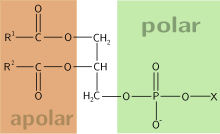Glycerol 3-phosphate

| |
| Names | |
|---|---|
| Preferred IUPAC name
(2R)-2,3-Dihydroxypropyl dihydrogen phosphate | |
| Other names
1,2,3-propanetriol, 1-(dihydrogen phosphate), (2R)-
D-glycerol 1-phosphate L-glycerol 3-phosphate L-α-glycerophosphate L-α-phosphoglycerol | |
| Identifiers | |
3D model (
JSmol ) |
|
| 3DMet | |
| 1723975 | |
| ChEBI | |
| ChEMBL | |
| DrugBank | |
ECHA InfoCard
|
100.000.279 |
| EC Number |
|
| KEGG | |
| MeSH | Alpha-glycerophosphoric+acid |
PubChem CID
|
|
| UNII | |
CompTox Dashboard (EPA)
|
|
| |
| |
| Properties | |
| C3H7O6P | |
| Molar mass | 170.057 g·mol−1 |
| Related compounds | |
Related organophosphates
|
Glycerol 1-phosphate Glycerol 2-phosphate |
Except where otherwise noted, data are given for materials in their standard state (at 25 °C [77 °F], 100 kPa).
| |
sn-Glycerol 3-phosphate
Biosynthesis
Glycerol 3-phosphate is synthesized by reducing
It is also synthesized by the phosphorylation of glycerol, which is generated by hydrolysis of fats. This esterification is catalyzed by glycerol kinase.
Metabolism and biological function

Glycerol 3-phosphate is a starting material for de novo synthesis of
 + Acyl-CoA → Lysophosphatidic acid + CoA
+ Acyl-CoA → Lysophosphatidic acid + CoA
Glycerol-1-phosphatase catalyzes the hydrolysis of glycerol 3-phosphate to regenerate glycerol, allowing glycerol fermentation to produce glycerol from glucose through glycolysis pathway. A number of organisms express this enzyme.[2]
 + H2O →
+ H2O →  + Pi
+ Pi
Shuttle system
Glycerol-3-phosphate dehydrogenases are located both in the
The Glycerol 3-phosphate shuttle is an emergency back-up system to supply neurons' demand of energy.[3]
Dephosphorylation
Glycerol-3-phosphate was found to be a substrate for the enzyme phosphoglycolate phosphatase (PGP, or G3PP) in mammals in 2015.[2] G3PP activity has subsequently been suggested to have a regulatory role in central metabolism[2] and stress response.[4]
Glycerol 1-phosphate
Glycerol 1-phosphate, sometimes called as D-glycerol 3-phosphate, is the enantiomer of glycerol 3-phosphate. Eukaryotes use the 3-phosphate, or L-configuration, for glycerolipid backbone. The 1-phosphate is specifically found in archeal lipids.[5]
Notes
- ^ This article uses stereospecific numbering where stereoconfiguration is not explicitly specified.
- ^ Equally appropriate names in biochemical context include glycerol-3-phosphate, 3-O-phosphonoglycerol, 3-phosphoglycerol[1] and Gro3P.
- ^ G. P. Moss (ed.). "Nomenclature of Phosphorus-Containing Compounds of Biochemical Importance". Archived from the original on 2016-12-08. Retrieved 2015-05-20.
- ^ PMID 26755581.
- ^ "Neuronal Back-up System Discovered". August 30, 2022.
- PMID 35017476.
- PMID 28007654.
